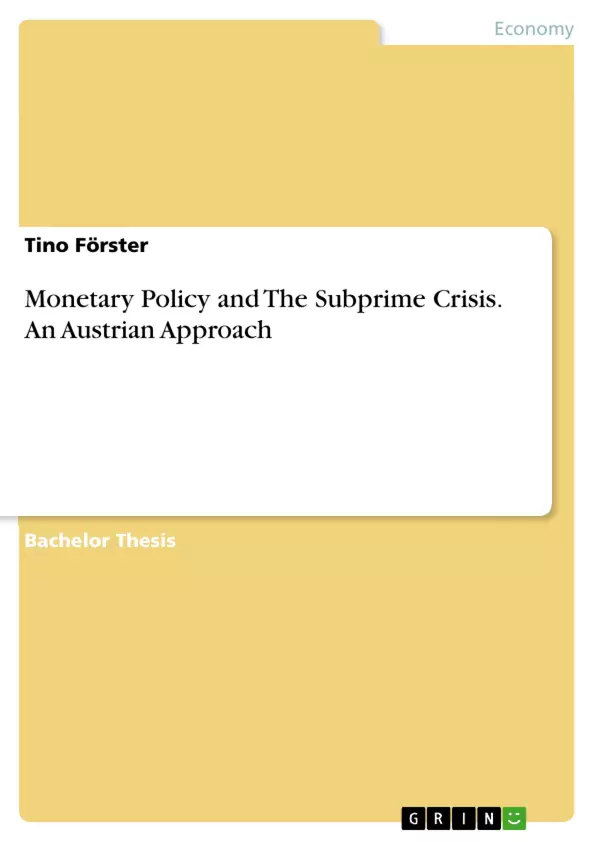The role of central banks and monetary policy in modern economies is a highly controversial topic. This paper attempts to show the relationship between monetary policy and the development of economic crisis, especially the recent Subprime Crisis in the USA. For this purpose the first part of the paper examines the Austrian theory of the business cycle and its illustration, the capital-based macroeconomics model. According to the Austrian theory artificially low interest-rates are responsible for misallocations of resources within the in-tertemporal capital structure and, consequently, reoccurring fluctuations within the eco-nomic system.
The second part of the paper applies the Austrian theory of the business cycle to the Sub-prime Crisis and investigates the role of the Federal Reserve System for the development of the crisis.
Ultimately, this paper states that expansionary monetary policy and flawed government regulations were the cause for unbalanced changes in the American structure of production and the recession.
Inhaltsverzeichnis (Table of Contents)
- Introduction
- The Austrian Theory of the Business Cycle
- Capital-based macroeconomics
- The market for loanable funds
- The production possibilities frontier (PPF)
- Stages of production
- Capital-based macroeconomics model
- The Business Cycle
- Monetary expansion, the market for loanable funds and the PPF
- Artificial interest-rates and the structure of production
- Boom and Bust
- The Subprime Crisis and the Austrian Theory
- Monetary policy and regulation before and during the crisis
- Application of the theory
- Evaluation of the Subprime crisis
- Conclusion
Zielsetzung und Themenschwerpunkte (Objectives and Key Themes)
This paper aims to demonstrate the relationship between monetary policy and the occurrence of economic crises, focusing on the Subprime Crisis in the United States. It examines the Austrian theory of the business cycle and its underlying model, capital-based macroeconomics, to analyze the impact of artificially low interest rates on resource allocation and economic fluctuations. The paper then applies this theory to the Subprime Crisis, exploring the role of the Federal Reserve System in the development of the crisis. Key themes of the paper include:- The Austrian theory of the business cycle
- Capital-based macroeconomics
- The impact of monetary policy on economic cycles
- The role of the Federal Reserve System in the Subprime Crisis
- The consequences of unbalanced changes in the structure of production
Zusammenfassung der Kapitel (Chapter Summaries)
The paper begins with an introduction that outlines the controversy surrounding the role of central banks and monetary policy in modern economies. Chapter 1 delves into the Austrian theory of the business cycle, explaining how artificially low interest rates can lead to misallocations of resources and economic fluctuations. This chapter examines the capital-based macroeconomics model, exploring the relationship between the market for loanable funds, the production possibilities frontier, and stages of production. Chapter 2 focuses on the application of the Austrian theory to the Subprime Crisis. It investigates the monetary policy and regulations employed before and during the crisis, analyzing the actions of the Federal Reserve System. The chapter also examines the impact of these policies on the American structure of production. Finally, the paper concludes by arguing that expansionary monetary policy and flawed government regulations were the primary causes for the unbalanced changes in the structure of production and the ensuing recession.Schlüsselwörter (Keywords)
The primary keywords and focus topics of this paper include the Austrian theory of the business cycle, capital-based macroeconomics, monetary policy, the Subprime Crisis, the Federal Reserve System, economic fluctuations, resource allocation, and the structure of production.- Quote paper
- Tino Förster (Author), 2014, Monetary Policy and The Subprime Crisis. An Austrian Approach, Munich, GRIN Verlag, https://www.grin.com/document/279914



